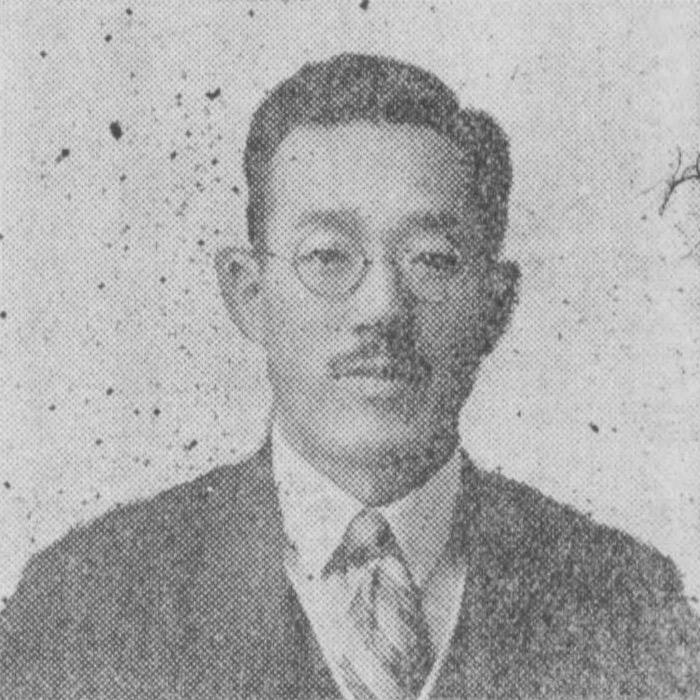

平泉 澄
Kiyoshi HIRAIZUMI, 1895-1984


☆ 平泉澄(ひらいずみ きよし、1895年2月15日 - 1984年2月18日)は、日本の歴史学者、東京帝国大学教授である。皇国史観で知られ、日本の保守・ナショナリズム政治に大きな影響を与えた。平泉寺白 山神社の神職でもあった。
★平泉 澄(ひらいずみ きよし、 1895年〈明治28年〉2月15日 - 1984年〈昭和59年〉2月18日)は、日本の国史学者。文学博士。専門は日本中世史。東京帝国大学教授。号は布布木の屋、寒林子、白山隠士[要出典]。 福井県出身の国史学者。東京帝国大学教授、平泉寺白山神社第4代宮司、皇學館大学学事顧問等を歴任。白山神社名誉宮司、玄成院第二十四世。 国体護持のための歴史を生涯にわたって説き続けたことから、「代表的な皇国史観の歴史家」といわれており[注 1]、彼の歴史研究は「平泉史学」と称されている。近衛文麿など[注 2]政界とのつながりも深かった[3]。 日本を守る国民会議の結成に際して、発起人として参加している[4]。著作に『中世に於ける社寺と社会との関係』(1926年11月15日)、『国史学の骨髄』(1932年9月18日)など。| Hiraizumi Kiyoshi
(平泉 澄, 15 February 1895 – 18 February 1984) was a Japanese historian
and professor of history at the Imperial University of Tokyo. He is
best known for Kōkoku Shikan (皇國史観, the emperor-centred view of
history) theory and was highly influential in Japanese conservative and
nationalist politics. He was also a shinto priest at Heisenji Hakusan
Shrine. |
平泉澄(ひらいずみ きよし、1895年2月15日 -
1984年2月18日)は、日本の歴史学者、東京帝国大学教授である。皇国史観で知られ、日本の保守・ナショナリズム政治に大きな影響を与えた。平泉寺白
山神社の神職でもあった。 |
| Life and work Hiraizumi was born on 15 February 1895 to a father who was a priest at the Heisenji Hakusan shrine in Katsuyama.[1] He was educated at Fourth Higher School (Kanazawa University), graduating from Tokyo Imperial University in 1918.[2][3] He began working as a lecturer at his alma mater only a few years later, in 1923, and three years later held the post of associate professor in the Faculty of Letters; in 1935 he was promoted to full professor.[4] He also helped to found the History Education Seminar, which oversaw the content of history textbooks; he also contributed to educational materials for both the police and the military.[3] Hiraizumi promulgated an approach to history known as kōkoku goji shikan, a highly nationalist view centred on the importance of Imperial Japan.[1][2] This view gained official endorsement from the Ministry of Education.[5] Despite being technically subordinate to the departmental head, Kuroita Katsume, Hiraizumi was considered by the faculty's students to be in charge of the history department.[6] With the backing of the Ministry, Hiraizumi created a new course known as Nihon shisoshi koza or History of Japanese Thought, which was highly politicised, emphasising Hiraizumi's belief in the divine origin of the Japanese Imperial line.[4] He also chaired a political student organisation named the Shukokai, which promulgated nationalist views enshrining the importance of the Emperor,[7] and was appointed by Kanokogi Kazunobu as a member of the Dai Ajia Kyokai (Greater Asian Association), a group of politicians, diplomats and others which was dedicated to spreading Japanese nationalist thinking throughout Asia. This society included Kōki Hirota, Konoe Fumimaro and Araki Sadao among its members, as well as many other notable personages.[8] Hiraizumi had travelled in Europe during the early 1930s.[2] He took inspiration from the German nationalism of Gottlieb Fichte, but was heavily critical of the French Revolution, considering the concept of civilian revolution to be an entirely foreign concept to the Japanese.[3] Hiraizumi resigned from the University after the Allied Occupation, and returned to his home prefecture of Fukui, though he continued to give lectures.[3] He continued to espouse nationalist views and argued in favour of a mythology-based version of history (even his later books claim the Emperor Jimmu was a real historical figure and treat the Nihon Shoki and Kojiki as historical sources).[9] However, without Hiraizumi's presence the ultra-nationalist trends of the University's history department began to be reversed, and his views began to fall out of fashion, replaced by Marxist historiography.[10] Eventually, Hiraizumi took up his father's role as a priest at the Heisenji Hakusan Shrine, where the spirit of Izanami is enshrined; on his retirement in 1981 the role passed to his son, Akira Hiraizumi.[3][1] Hiraizumi died on 18 February 1984. https://en.wikipedia.org/wiki/Hiraizumi_Kiyoshi |
生涯と仕事 平泉は1895年2月15日、勝山の平泉寺白山神社の宮司であった父のもとに生まれた[1]。第四高等学校(金沢大学)で学び、1918年に東京帝国大学 を卒業した[2][3]。 母校で講師として働き始めたのはわずか数年後の1923年で、3年後には文学部助教授となり、1935年には正教授に昇進した[4]。また、歴史教科書の 内容を監修する歴史教育ゼミナールの設立に尽力し、警察や軍隊の教材にも貢献した。 [3]平泉は、皇国御史観として知られる歴史観を広めた。この歴史観は、大日本帝国の重要性を中心とする高度な国家主義的見解であり、文部省の公式な支持 を得た[1][2]。 [平泉は文部省の後ろ盾を得て、「日本思想史講座」という新しい講座を開設したが、これは日本の皇統の神的起源に対する平泉の信念を強調するもので、非常 に政治的なものであった[6]。 4]彼はまた、天皇の重要性を謳う国家主義的な見解を広めた政治的な学生組織「修交会」の議長も務め[7]、アジア全域に日本の国家主義的な考え方を広め ることを目的とした政治家、外交官などのグループである「大亜細亜協会」のメンバーに、鹿子木一信によって任命された[8]。この協会のメンバーには、広 田弘毅、近衛文麿、荒木貞夫のほか、多くの著名人が含まれていた[8]。 平泉は1930年代初頭にヨーロッパを旅行していた[2]。彼はゴットリープ・フィヒテのドイツ国民主義からインスピレーションを得たが、フランス革命に は激しく批判的であり、市民革命という概念は日本人にとって全く異質なものであると考えていた[3]。 連合国軍の占領後、平泉は大学を辞職し、故郷の福井県に戻ったが、講義は続けていた[3]。平泉はナショナリスト的な考えを支持し続け、神話に基づく歴史 を主張した(後の著書でも神武天皇は実在の歴史上の人物であり、日本書紀や古事記を史料として扱っていると主張している)[9]。 [しかし、平泉の存在がなければ、大学の歴史学部の超国家主義的な傾向は逆転し始め、彼の見解はマルクス主義的な歴史学に取って代わられ、廃れ始めた。 [10]やがて平泉は、イザナミの霊が祀られている平泉寺白山神社の神官として父の役割を引き継いだ。1981年に引退すると、その役割は息子の平泉明に 引き継がれた[3][1]。平泉は1984年2月18日に死去した。 |
| Major works Chusei ni okeru seishin seikatsu (Spiritual Life in Medieval Japan), 1926[2] Chusei ni okeru shaji to shakai to no kankei (The Relationship of Shrines and Temples in the Society of Medieval Japan)[2] Kokushigaku no kotsuzui (The Heart of National History)[2] Kenmu chuko no hongi (True Meaning of the Kenmu Restoration), 1934[2] Shonen Nihon Shi (Japanese History for Young People), 1970[3] |
著作 平泉の著作の全容は、弟子の田中卓によって以下の文献にまとめられている。 『平泉史学と皇国史観』田中卓著、青々企画、2000年。 『平泉澄博士全著作紹介』田中卓編著、勉誠出版、2004年。 肖像と略歴、著作年譜のほか研究文献目録も収められている。 ほかに錦正社で、約十冊が新版再刊されている 評伝 神道史學會(神道史学会)『神道史研究・平泉澄博士と神道』 1985年1月 日本学協会『日本・平泉澄先生を偲ぶ』 1985年2月 藝林会『藝林・平泉澄先生追悼』 1986年3月 今谷明「平泉澄」(今谷明・大濱徹也ら編『20世紀の歴史家たち』(1)所収。刀水書房、1997年7月) 田々宮英太郎『神の国と超歴史家・平泉澄』 雄山閣出版、2000年11月 田中卓『平泉史学と皇国史観』 青々企画 2000年12月 植村和秀『丸山眞男と平泉澄』(パルマケイア叢書)柏書房 2004年10月 若井敏明『平泉澄』(ミネルヴァ日本評伝選)ミネルヴァ書房 2006年4月 田中卓『平泉史学の神髄』 国書刊行会 2012年12月 立花隆『天皇と東大-大日本帝国の生と死 下』文藝春秋、2005年 坂口太郎『大正・昭和戦前期における徳富蘇峰と平泉澄―その史学史的考察―』北九州市立松本清張記念館、第19回松本清張研究奨励事業研究報告書、 2019年 |
| 同年、東京帝国大学講師。1925年(大正14年)より1年間、自宅に
学生を集め洞院公賢の日記『園太暦』の講読会を行う。 1926年(大正15年)、東京帝国大学助教授。1927年(昭和2年)秩父宮雍仁親王に謁見。1929年(昭和4年)高松宮宣仁親王に謁見[注 3]。 1930年(昭和5年)歴史学研究法の追求と大学の史学研究室の在り方、フランス革命の研究を目的に欧米外遊[注 4]。1931年(昭和6年)7月に帰国後、学生の思想教導に携わる[注 5]。 1932年(昭和7年)東京帝大の学生団体「朱光会」会長に就任。昭和天皇に「楠木正成の功績」を進講。 1933年(昭和8年)4月に「青々塾」開塾。軍の教育機関で講義を行う。満洲視察。満洲国執政愛新覚羅溥儀と会見。 1935年(昭和10年)2月、史学会の常務理事に就任。同年3月、東京帝国大学教授に昇任。 1938年(昭和13年)満洲建国大学の創設に参画。1940年(昭和15年)3月、満洲で皇帝溥儀に「日本と支那及西洋諸国との国体及び道義の根本的差 異に関する講話」を進講。 1941年(昭和16年)12月、海軍勅任嘱託就任[注 6]。 終戦後 1945年(昭和20年)8月17日、東京帝国大学教授辞職[注 7]。1946年(昭和21年)白山神社第3代宮司就任。1948年(昭和23年)公職追放となる[注 8]。 1954年(昭和29年)東京銀座に国史研究室を設置[注 9]。1958年(昭和33年)東京都品川区に転居。 1984年(昭和59年)2月18日、肺炎のため死去。89歳没。 https://x.gd/CmL8w |
|
リ ンク
文 献
そ の他の情報
Copyleft, CC, Mitzub'ixi Quq Chi'j, 1996-2099
☆
 ☆
☆